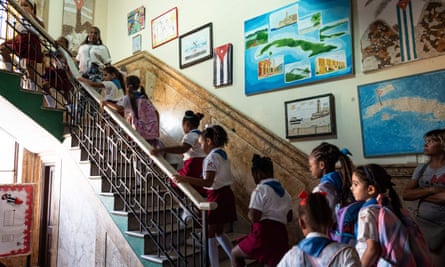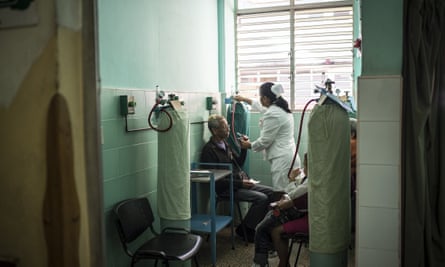Every morning before dawn, hundreds of people line up outside the US embassy. At midday this particular day, Acelia De La Osa, a 71-year-old retired physics teacher with frizzy hair, bounds out of the sleek modernist building and hugs her daughter. They both laugh with tears in their eyes: Acelia’s got a visa and will soon be in Florida.
Her daughter, Ana Delia, the only one of her siblings left on the island, also hopes to get out once her visa comes through. An intensive care nurse, she has seen her salary’s purchasing power – now the equivalent of just $18 a month – cut in half over the last three years by inflation.
“Health and education are the two toughest sectors in this country,” she said. “They pay you little and you work loads.”
As well as her tiny wage, she cited the piecemeal education her children now receive as another reason for wanting to leave. With a mass exodus of teachers from schools, there’s nobody to teach her 13-year-old twins maths.
State wages in Cuba have plummeted in recent years as “maximum pressure” US sanctions have created massive shortages and stoked runaway inflation. Meanwhile, squeezed public sector workers have more options than before: emigration out of the country is smashing records, while a resurgent private sector hoovers up much of the talent that remains.
The upshot is that the state is suffering an unprecedented brain drain: health and education, long seen as the “pillars” of the Revolution, are fraying as qualified personnel empty out.

At a school for autistic children in the capital’s Vedado neighborhood, director Elsa Escalona, 72, has lost 13 teachers over the last two years. Four have emigrated to the US – two with undergraduate degrees, two with master’s degrees. She’s had to increase class sizes from the recommended five to nine students per class.
“You feel impotent because there’s no way to convince people to stay,” said Escalona, who just about gets by on her and her husband’s state salaries. “Some teachers have cried because they haven’t wanted to leave, but the economic situation is overwhelming – they feel they need to go.”
Cuba invests more in health and education than any other Latin American country, and Cubans have for decades benefited from results in these sectors comparable to developed countries. But official figures show the number of doctors, nurses and dentists is falling sharply. In October, the ministry of education announced it was 17,278 teachers short.
Two years ago, the government allowed Cubans to incorporate businesses and import goods. Since then, the private sector, long reined in by the Communist party, has roared back and now employs more than a third of the island’s workforce, according to economists. Small and medium-sized businesses, which pay many times more than the state and can employ up to 100 people, are guzzling up many of the best and brightest.
In addition, a new layer of US sanctions, implemented by Trump and largely kept in place by Biden, have succeeded in their stated aim of starving the Cuban economy of hard currency. Economists say the new measures cost the island’s economy billions of dollars a year. Caked on to a botched currency unification three years ago, the economic damage wrought by the pandemic and a highly dysfunctional planned economy, they have created a perfect storm.

“The conditions under which the government is operating are impossible,” said Emily Morris, a development economist at University College London. “These new sanctions have caused a severe decline in living standards. Given that one of the effects of sanctions is to obstruct the government’s access to international finance, there’s nothing else they can do because they have no foreign exchange cushion.”
The government of Raúl Castro eliminated the need for an e


